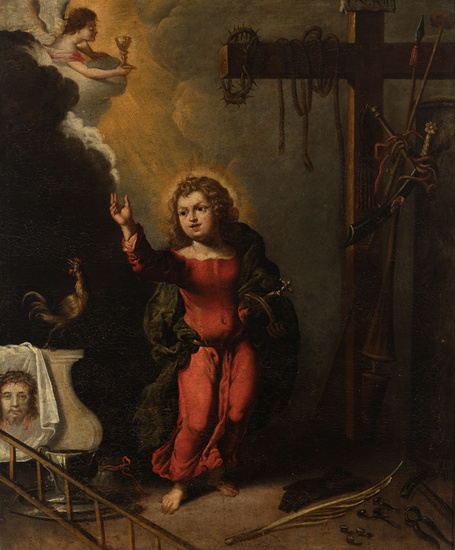Andalusian School; XVII century.
Andalusian School; XVII century.
"Infant Jesus with the attributes of the passion".
Oil on canvas. Relined.
It presents restorations in the pictorial surface.
It preserves frame of the seventeenth century with polychrome of later period.
Measurements: 124 x 101 cm; 143 x 123 cm (frame).
In the center of this devotional scene we find the figure of Jesus Child dressed in red tunic, symbol of the passion of Christ. Not only the tunic, but the entire scene in which the scene takes place has been conceived with the intention of showing the viewer the fate of this innocent child with blond curls. In the right area stands the cross on which rests the crown of thorns that remains on a crossbar, but we also see the spears and the whip with which they harassed Christ. On the floor at the foot of the cross the nails and the palm of martyrdom that serves compositionally to create a diagonal that connects with the staircase that goes to the left of the scene, elements that have been arranged in such a way that exalt the figure of the protagonist. The left zone also has a large still life that narrates the last moments of Jesus, the bag with the coins for which Judas betrays him, the Veronica, the rooster that alludes to the moment in which Peter renounces Christ and finally in the upper zone in a break of Glory the angel that appears to him in the Garden of Olives. In short, the artist deploys a whole narrative around the innocent figure of a child, surpassing the traditional images where the Child usually appears only with the nails and the cross.
The Divine Infant was a very popular typology throughout the 17th century. Christian art delighted throughout its history, and especially in the Modern Age, projecting the innocent infancy of Jesus next to the representation of the cross. The contrast between the happy unconcern of a child and the horror of the sacrifice to which he was predestined was designed to move hearts. This idea was already familiar to the theologians of the Middle Ages, but the artists of the time expressed it discreetly, either through the worried expression of the Virgin, or through the bunch of grapes that the Child squeezes in his hands. It was especially in the art of the Counter-Reformation that this funeral presentiment of the Passion was expressed by means of transparent allusions.
COMMENTS
It presents restorations in the pictorial surface.
View it on
Estimate
Time, Location
Auction House
Andalusian School; XVII century.
"Infant Jesus with the attributes of the passion".
Oil on canvas. Relined.
It presents restorations in the pictorial surface.
It preserves frame of the seventeenth century with polychrome of later period.
Measurements: 124 x 101 cm; 143 x 123 cm (frame).
In the center of this devotional scene we find the figure of Jesus Child dressed in red tunic, symbol of the passion of Christ. Not only the tunic, but the entire scene in which the scene takes place has been conceived with the intention of showing the viewer the fate of this innocent child with blond curls. In the right area stands the cross on which rests the crown of thorns that remains on a crossbar, but we also see the spears and the whip with which they harassed Christ. On the floor at the foot of the cross the nails and the palm of martyrdom that serves compositionally to create a diagonal that connects with the staircase that goes to the left of the scene, elements that have been arranged in such a way that exalt the figure of the protagonist. The left zone also has a large still life that narrates the last moments of Jesus, the bag with the coins for which Judas betrays him, the Veronica, the rooster that alludes to the moment in which Peter renounces Christ and finally in the upper zone in a break of Glory the angel that appears to him in the Garden of Olives. In short, the artist deploys a whole narrative around the innocent figure of a child, surpassing the traditional images where the Child usually appears only with the nails and the cross.
The Divine Infant was a very popular typology throughout the 17th century. Christian art delighted throughout its history, and especially in the Modern Age, projecting the innocent infancy of Jesus next to the representation of the cross. The contrast between the happy unconcern of a child and the horror of the sacrifice to which he was predestined was designed to move hearts. This idea was already familiar to the theologians of the Middle Ages, but the artists of the time expressed it discreetly, either through the worried expression of the Virgin, or through the bunch of grapes that the Child squeezes in his hands. It was especially in the art of the Counter-Reformation that this funeral presentiment of the Passion was expressed by means of transparent allusions.
COMMENTS
It presents restorations in the pictorial surface.



